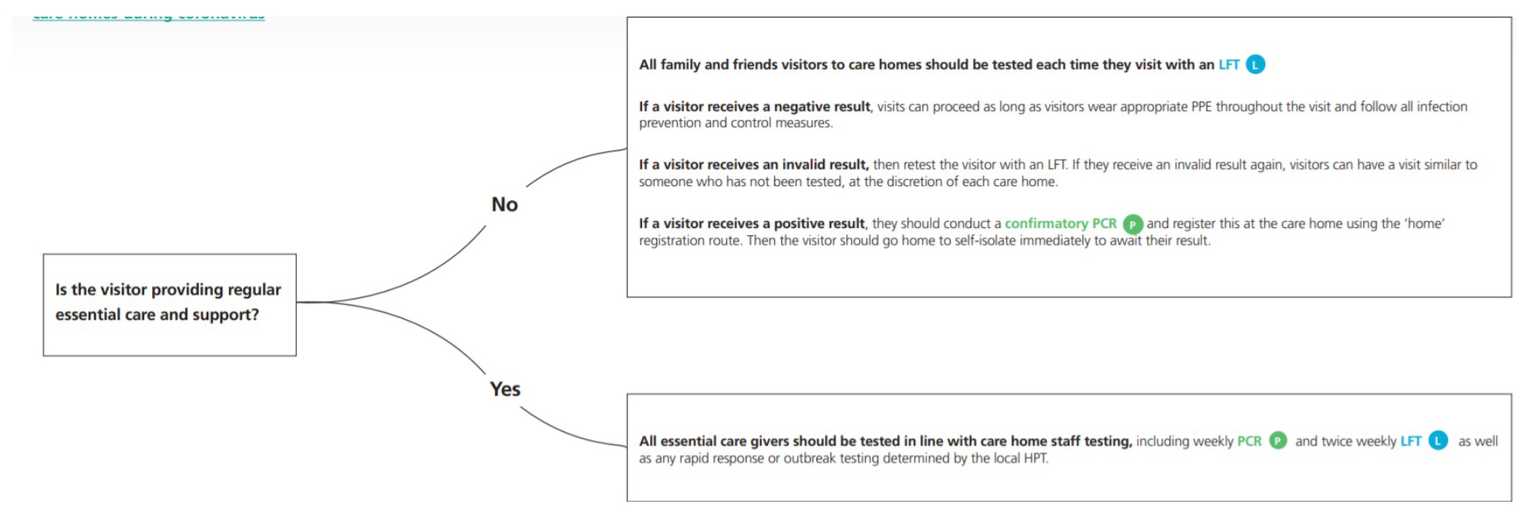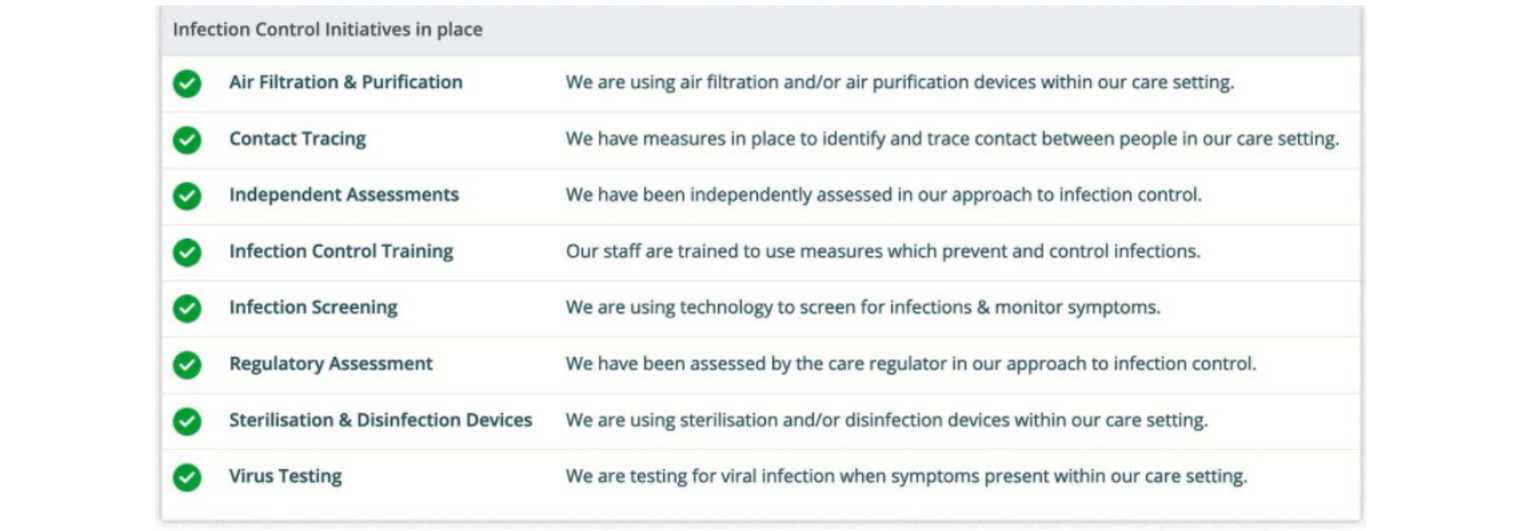Posted by Rachel Bashford
Care home infection control: What you need to know
Searching for the right care home for yourself or a loved one can be a challenge. Knowing what to expect with infection control measures in care homes can set your mind at ease and help smooth the process.
Practical arrangements in care homes have changed quite a bit over the last 18 months. It’s been hard for most people to try and keep up with guidance, as every home has their own way of doing things.
This article aims to keep you up to date with all the news about what to expect going forward when you enter a care setting, for a visit or for a stay.
Here are all the latest updates on:
- What infection control should be in place in care homes
- Preparing to enter a care setting
- Searching for information about care settings and infection control guidance.
What infection controls should you expect in a care home?
Everyone knows how confusing the changes to official guidelines about safety have been since the beginning of the pandemic. There has been uncertainty about what controls were best to protect everyone, particularly vulnerable people. As we move forwards, some guidelines may be relaxed and others may stay in place.
The key points from the most recent government guidance are:
- Strong advice to receive vaccine when offered to you
- You will be asked to take a lateral flow test on the day and provide a negative result before entering a care setting
- Avoid travelling on public transport before entering a care setting
- Reduce social contact before visit or stay
- Wash hands frequently and avoid touching face/mouth in a care home
- Follow care home’s social distancing measures
- Wear appropriate PPE, such as a mask. Disposable gloves/aprons may be provided.
You can read the government guidelines in full here.
Some people might ask, if most of the older generation have had their second jab, why do we still need these measures? There are some vulnerable people who can’t be vaccinated yet for medical reasons, and not everyone has had their second vaccine.
Although we are all beginning to feel a little more confident that slowly our country is opening up and we are living in a safer environment, no one can be sure that the pandemic is entirely over, particularly for more vulnerable people.
To confirm this perspective, Sam Monaghan, the chief executive of MHA homes (one of the UK’s largest care providers) shared on Twitter on 10 May, “It hasn’t been an easy journey, and it’s not over yet.”
So, why is this important? If you are seeking a good care setting, perhaps for yourself or a loved one, you need to be aware of what regulations a care home will expect you to follow. It’s good to get ahead and be prepared so that a visit or stay are not stressful experiences.
For many people, wearing PPE and arranging a test are the biggest issues to overcome when in a care home. Each care setting will have their own guidelines to follow, so it’s a sensible idea to get in touch with the one you are interested in to gather information about controls in place.
An example could be that some homes might want you to arrive early so that they can provide you with appropriate PPE to wear or just to talk you through expectations.
At Care UK, another major care home company, they have helpfully created a video to show what wearing PPE looks and feels like for everyone involved.
How can you prepare to enter a care home?
Testing is the most important aspect of arranging entry at the moment. The general guideline is if you want to enter a care setting, then organise a lateral flow test (LFT) on the day of your visit or stay. Once you have had a negative result, report that to the care setting so everything can run smoothly. Obviously, if there is a positive result, you will need to isolate.
Some homes run their own testing arrangements, so you might have to arrive an hour or so before to have a test and wait for the result. Others are happy for you to sort out a test yourself, either at home or an approved location (such as a testing centre). Asking the care home what they prefer is essential so that everyone is happy.
Gov UK have provided the outline below to show people what they should do in terms of testing if they are a regular visitor or just going into a care home on one occasion.

Julie Jones, from John’s Campaign, has said that if you are not happy with the rules in place for infection control in a certain care home, then ask for a copy of their risk assessment. This could help you to understand why guidelines are in place and how they help to keep people safe.
Many people who have experienced care since the start of the pandemic have been most frustrated about not being able to touch loved ones. Although physical contact, such as holding hands, is now allowed, hugging is still discouraged for the present time to protect vulnerable older people.
As Lesley Griffith, a manager of a care home in Bristol reports on Gov UK’s social care blog, restrictions are easing but “caution remains.” She remarks that, “We feel vulnerable, nervous of what might happen, but determined not to return to those awful days.”
If you are beginning to search for a care home for you or a loved one, then knowing how to protect yourself and others is vital for a happy time at a home. The time will come when there won’t be these restrictions in place, but for now it’s good to be aware of the situation.
How to search for care homes with infection control in place
Autumna has developed a search tab on its website to help you find the right care home for you or a loved one and to discover what infection control procedures are in place.
It’s called the S.A.F.E initiative and it stands for ‘Safety Assurance For Everyone’. You can find it here on the website.
This easy-to-follow system enables anyone seeking a care setting to search for a home that has excellent standards of infection control in place.
For the moment, only care providers with an enhanced listing on Autumna are able to display the S.A.F.E. badge – this includes home care, live-in care and retirement living developments too - but the plan is to make the accreditation more widely available across a whole range of platforms – not just on Autumna.

What does this S.A.F.E badge actually tell you about the home? Well, it shows that the hygiene processes laid out in government guidance are not only being met but exceeded, and it can also give you detailed information, amongst other things, about air purifiers used in the home, air flow management, testing regimes and infection control training for staff.
This is shown in the detailed list below, which is a sample of what you would read about a care home that interests you on the Autumna website.

The criteria cover the full spectrum of infection and hygiene procedures you would expect to be in place so that everyone is completely cared for. This also allows care homes to advertise all of their strong points, so as a care seeker, you are aware of everything they do to maximise their control over any potential infections that could enter the setting.
You can also search for safe visiting spaces in this section of the Autumna website, so you can see what a care home has in place to ensure safe and enjoyable visits with loved ones. When you are searching, click on the Additional Filters menu and select safe visiting spaces.
Autumna is keen to know how its S.A.F.E search process has helped you find the right care home. Has it answered all of your questions? Are there any important pieces of information that could be added? Your feedback is important to improve the validity of the S.A.F.E. infection control initiative.
Contact Us
Remember, you’re more than welcome to get in touch with the Autumna team if you’re looking for support yourself or for an elderly family member.
Whether you need care, legal, or financial advice for later life, we’re here to help.
You can contact us by either phone or email. The details are below:
Phone: 01892 335 330
The line is open Monday to Sunday (8:30am - 5:30pm Mon-Fri, 10am - 5pm Sat, 10am - 4pm Sun).
Email: info@autumna.co.uk
Other articles to read
Autumna Blog

Older Persons Care Advice
The Effects of Music Therapy on People Living with Dementia
March 12th, 2024
How can music help people with dementia feel calmer, happier and more connected to people? Find dementia-friendly playlists here.

Older Persons Care Advice
Day Care – A first step, respite, or to have fun!
March 12th, 2024
A chance to socialise means the world to some older people. Day Care services for respite provide an opportunity to laugh, learn and listen to like-minded people. Here's how.

Older Persons Care Advice
How Much do Pensioners Need a Year to Retire?
February 8th, 2024
Women's retirement savings are on average £69,000 while men's savings equate to £205,000. Autumna looks at why women’s retirement funds are less than men's in the UK and how that affects their choice of care.






